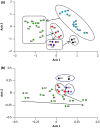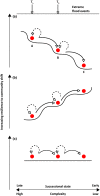River ecosystem resilience to extreme flood events
- PMID: 30250708
- PMCID: PMC6145017
- DOI: 10.1002/ece3.4300
River ecosystem resilience to extreme flood events
Abstract
Floods have a major influence in structuring river ecosystems. Considering projected increases in high-magnitude rainfall events with climate change, major flooding events are expected to increase in many regions of the world. However, there is uncertainty about the effect of different flooding regimes and the importance of flood timing in structuring riverine habitats and their associated biotic communities. In addition, our understanding of community response is hindered by a lack of long-term datasets to evaluate river ecosystem resilience to flooding. Here we show that in a river ecosystem studied for 30 years, a major winter flood reset the invertebrate community to a community similar to one that existed 15 years earlier. The community had not recovered to the preflood state when recurrent summer flooding 9 years later reset the ecosystem back to an even earlier community. Total macroinvertebrate density was reduced in the winter flood by an order of magnitude more than the summer flood. Meiofaunal invertebrates were more resilient to the flooding than macroinvertebrates, possibly due to their smaller body size facilitating greater access to in-stream refugia. Pacific pink salmon escapement was markedly affected by the winter flood when eggs were developing in redds, compared to summer flooding, which occurred before the majority of eggs were laid. Our findings inform a proposed conceptual model of three possible responses to flooding by the invertebrate community in terms of switching to different states and effects on resilience to future flooding events. In a changing climate, understanding these responses is important for river managers to mitigate the biological impacts of extreme flooding effects.
Keywords: climate change; extreme floods; macroinvertebrates; meiofauna; recovery; resilience; salmonids.
Figures






References
-
- Brown, L. E. , Khamis, K. , Wilkes, M. , Blaen, P. , Brittain, J. E. , Carrivick, J. L. , & Milner, A. M. (2018). Functional diversity and community assembly of river invertebrates show globally consistent responses to decreasing glacier cover. Nature Ecology & Evolution, 2(2), 325 10.1038/s41559-017-0426-x - DOI - PubMed
-
- Brown, L. E. , & Milner, A. M. (2012). Rapid loss of glacial ice reveals stream community assembly processes. Global Change Biology, 18(7), 2195–2204. 10.1111/j.1365-2486.2012.02675.x - DOI
-
- Coumou, D. , & Rahmstorf, S. (2012). A decade of weather extremes. Nature Climate Change, 2(7), 491–496. 10.1038/nclimate1452 - DOI
-
- Dole‐Olivier, M. J. , Galassi, D. M. P. , Marmonier, P. , & Creuzé Des Châtelliers, M. (2018). The biology and ecology of lotic microcrustaceans. Freshwater Biology, 44(1), 63–91. 10.1046/j.1365-2427.2000.00590.x - DOI
-
- Flory, E. A. , & Milner, A. M. (1995). The role of competition in invertebrate community development in a recently formed stream in Glacier Bay National Park. Aquatic Ecology, 33, 175–184.
LinkOut - more resources
Full Text Sources
Other Literature Sources

